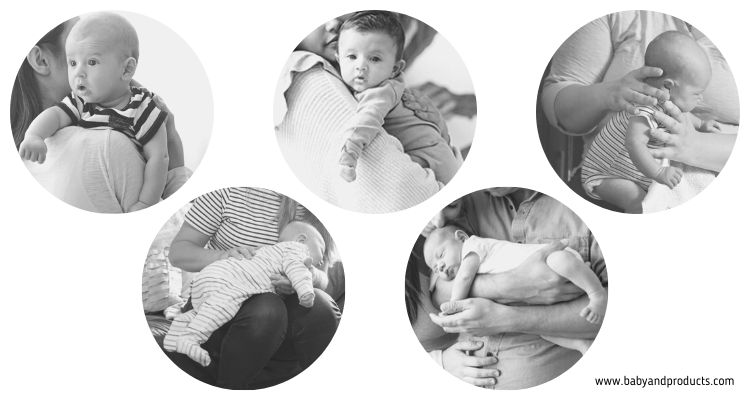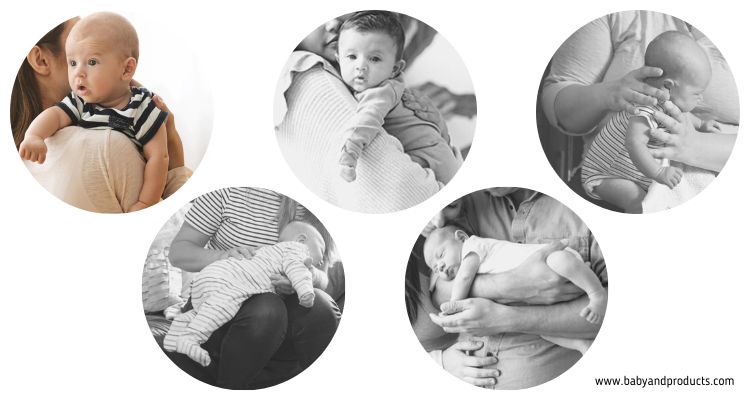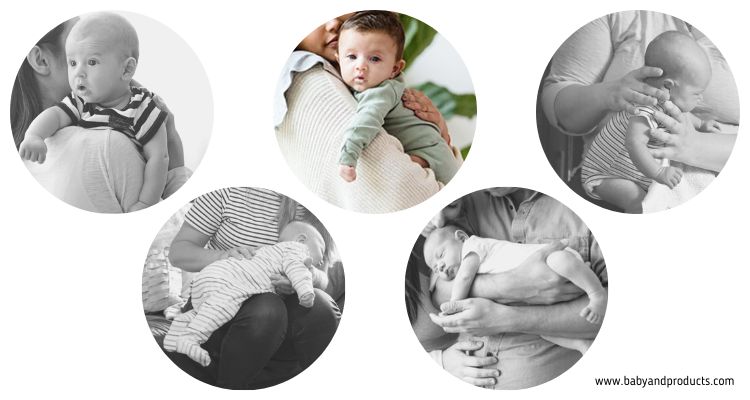Navigating parenting can be tough, especially for first-timers. One of the key questions is how long to burp your baby after a bottle? This is something that often stumps new parents, but the answer will vary from one infant to another.
Parents often worry if their babies have too many gas issues. It can be tiring for both the baby and the parent; however, it’s equally important to understand when enough is enough and stop burping. Too much of it can be unnecessary and may even make the baby more uneasy.
In this blog, we’ll discuss what signs to look for to know when it’s time to stop burping your baby after they’ve been fed with a bottle. Read on for some useful tips on how to make the process less exhausting for both you and your little one.
When do you stop burping a baby after a bottle?
As a seasoned mother, I can tell you that burping is a crucial part of parenting. It allows your little one to release excess air from their stomach that was swallowed during feeding, promoting comfort and preventing discomfort like colic and gas.
When it comes to burping a bottle-fed baby, it’s important to understand that they tend to swallow more air than breastfed babies. That’s why it’s advisable to burp them within 2-6 minutes after each bottle. The frequency of burping will depend on the age and feeding habits of your baby, but as a general rule, newborns should be burped every 2-3 ounces.
Doctors highly recommend breastfeeding your baby for at least 6 months as it helps prevent these uncomfortable conditions. However, it’s essential to keep in mind that the burping needs of babies can vary, and if you’re breastfeeding, your baby will burp in a few minutes since they have not swallowed much air.
📑 TL;DR
- Burping is important for releasing excess air swallowed during feeding
- Depends on baby’s age and feeding habits
- Newborns should be burped every 2-3 ounces
- Bottle-fed babies swallow more air, can lead to discomfort and infections
- Doctors recommend breastfeeding for at least 6 months
- Bottle-fed babies burp within 2-6 minutes after each bottle.
When to stop burping breastfeeding babies?
Breastfed babies tend to swallow less air than bottle-fed babies.
- Breastfeeding babies are mostly newborns from 0-6 months of age.
- If you follow the burping methods, your baby will burp within 5-15 minutes.
- Try burping your baby for at least two minutes straight, but if they haven’t burped yet, it means they are not ready.
- Lay them in their crib for 5 minutes. Clean their face or change the diaper if you have to, and then try burping again.
- Burping techniques work differently with every baby and with every touch. How does that one person in the house burp a baby within a few minutes? Well, that depends on the burping method they are using and their hands’ touch.
- Nursing mothers should burp their babies during switching breast sides so that the extra air is removed from the baby’s tummy and they can feed fully.

How to burp your baby? 5-Steps I used to burp mine
There are different burping techniques that you can try and test on your baby to check which one is more effective. Make sure you are putting your baby in a semi-upright position. Remember that this position must add a little pressure on their tummy.
Following are the different burping positions to burp your baby. You might struggle a little before getting your baby to that perfect and comfortable burping position. No matter what position you may try, always remember to cover your clothes with a handkerchief if your baby spit ups.

1. The shoulder position
- Take your baby in your lap; if they are newborns, hold them very carefully.
- Hold the baby upright with their tiny head resting on one of your shoulders and its torso against your chest.
- Ensure that you are not adding any pressure on their neck or throat.
- Gently pat the back of your baby with one hand and support their body with the other hand.
- This position will help you to extract the gassy bubbles out of your baby’s tummy.

2. The chest position
- Take your baby to your chest and hold them firmly, with their head-turning sideways.
- Gently rub the back of your baby with one hand and support their body with the other hand.
- If your baby pulls your legs into a frog-like position, don’t stop them, as it will significantly help pass the gas.

3. The upright sitting position
- Bend your knee and let your baby sit in an upright sitting position on it.
- Make sure that their face is on your side.
- Gently hold them with your palm on their chest and softly place your fingers around their jaws. Do not put any pressure or weight on their neck and throat.
- Lean them a little forward towards you and use your other palm to pat or rub their back gently. The air bubbles will be released soon from their tummy.

4. Over your lap position
- Lie the baby on your lap with its belly down and head a bit higher than the body.
- Take your hand to support their chin; again, no pressure on the throat.
- Gently rub their back or slowly rock your legs sideways to make them burp.

5. The forearm position
- This position or technique should be done very carefully.
- Take out your forearm and lay your baby on it with the belly down, their legs swinging on both sides.
- Rest the head of your baby on your elbow’s crook and turn it to one side.
- Stand and rock your hand slowly, or you can also Pat their back gently.
- This is a very influential position for burping every little one after bottle or breastfeeding.
How to know if my baby needs to burp?
Babies, while growing, will show different signs to let you know that they need to burp. You can take hints from your baby if they are doing the following actions:
- They will go restless or will make unusual facial expressions.
- They move their legs and pull them closer to their chest. This also indicates that they have discomfort in their tummy.
- They act fussy or keep crying for no visible reason.
- The babies would not feed comfortably if they needed to burp first.
- They will face difficulty in latching from both breastfeeding and bottle feeding.
- They will reject the breast or bottle.
What if my baby is not burping after feeding?
If you have tried for almost 10-15 minutes and have no luck burping your baby, you cannot force a burp. If your baby is not burping easily, you can try different techniques to extract the ingested air from their tummy.
Try to burp them for 5-10 minutes; if they don’t burp, give them a break of 5-10 minutes. Do other work, like wrapping them in the swaddle or changing their diaper. Then burp them again; this time, they will burp.
If you have tried that and your baby still does not burp, then it is unnecessary to burp them. Maybe your baby has had a smooth feeding with a tight suction that prevents air from getting into the tummy.
Nonstop failed burping attempts can stress you for nothing. If the baby does not burp in 10 minutes after every technique, he probably does not need burping.
How to know if your baby can burp on their own?
If your baby has learned to sit up on their own, there is no longer your need to burp them. If they can sit unsupported, they can burp themselves unsupported.
When should I stop burping my baby at night?
Undoubtedly, it is essential to burp your baby before putting them to sleep to avoid any type of discomfort. But at the same time, nighttime is the most delicate time for the baby to sleep as they grow while sleeping. If you try hard to burp your baby at night, you might wake them up from a sound sleep.
- If your baby is a newborn, they will sleep immediately during or after feeding. It is less likely that their sleep will be disturbed if you burp them at night.
- If your baby is over the age of 4 months or can sit on their own, there is no need to burp them at night as they can do it for themselves.
- If you have a delicate cranky baby with gas issues, it is better to burp them after every feed at night if you don’t want to hear their wailing.
What are the effective methods to burp your sleeping baby?
Burping a sleeping baby is as big a challenge as an awake baby, but the methods are the same. You can apply all the burping techniques mentioned above to your sleeping baby. These techniques will make your sleeping baby burp and turn them into a deep sleep.
As long as your baby is an infant between 0-4 months, you can burp them without being afraid of their sleep because your infant will sleep anyway.
Some valuable tips for burping a baby
As a parent, you must have known by now that burping a baby is not an easy job. Here are some valuable tips you can read if you are learning the burping process:
- Consider burping as a part of the feeding process instead of taking it as a chore.
- Pay attention to the techniques that work and do not work in favor of your child; this will help you to burp your baby heartedly.
- Consider the demand for comfort for your baby as they cannot speak for themselves or tell you which part of their body is hurting.
- Note the small grins of relief your baby shows for a few seconds after they get out of the gas pain.
- Focus on the fact that this time will end soon, and your baby will eventually start doing everything on his own.
- Cherish the little burping moments with your munchkin.
Parents Also Ask
What if I put my baby to sleep without burping him?
You do not have to force burp your baby before putting them to bed if you have tried for several minutes or with all the techniques. Sometimes your baby does not need to burp. If your baby wakes up from gas pain in the middle of the night, pick up and burp them and put them back in the bed.
Can my baby choke in sleep if she sleeps without burping?
Babies have a natural reflex in them that help them to cough up, spit or vomit any fluid blocking their airways. So there is no chance or evidence that your baby could choke in their sleep after feeding.
What is the effective way to pat?
If you are patting your baby, using your hand in a cup shape is always better than using a flat palm. The cupped hand is gentler, and babies like it very much. Pat your baby at the lower back or between their shoulder blades.





